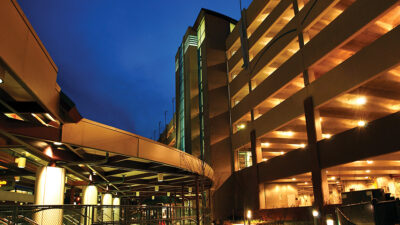Advances in technology have allowed designers to challenge the status quo, think outside the box, and design high-rises comprised mostly of wood. It’s critical to understand the history associated with high-rise construction, current trends in the industry, and insights on the code-development process associated with high-rise wood construction.
Learning objectives
- Learn about the difference between noncombustible and combustible construction materials.
- Understand why wood construction is becoming more common for high-rise buildings.
- Review the codes and standards as they relate to timber construction.
There has been a worldwide movement to use wood materials within high-rise buildings over the course of the past 20-plus years, and it has gained more exposure in the past 5 years. With stagnation in design comes innovation; and with most innovations, it takes time to reach the masses. The thought of constructing high-rise buildings out of wood, a combustible material, has design professionals’ interests piqued, code professionals dubious of the viability, and fire chiefs skeptical. How can a high-rise building be constructed of wood? It’s already a challenge to design, build, and protect in the event of fire, but there are codes, tests, and additional challenges to be aware of during the process.
Noncombustible vs. combustible construction
Many architects and engineers that design high-rise buildings are accustomed to noncombustible construction. The International Building Code (IBC) provides the design criteria for all buildings, and in general, the larger the building, the greater the likelihood that it’s going to be built of noncombustible, fire-resistive construction. The IBC requires a 50-story high-rise hotel tower to be constructed of Type IA construction (noncombustible construction), with structural members having a minimum fire-resistance rating and additional life safety features incorporated into the design.
Concrete and steel are industry standards for high-rise construction, but it wasn’t always that way. Part of the reason the industry moved away from wood was the Great Chicago Fire of 1871, which destroyed more than 17,000 structures over the course of 2 days. The fire was able to spread so easily due to the close proximity of wood structures. The aftermath spurred economic development, and architects were designing high-rises in place of the structures that fell due to the fire. Based on the recent past, the use of noncombustible materials was seen as favorable. Now in the 21st century, as steel prices continue to climb and with a greater emphasis being placed on sustainability, wood is making a comeback.
The wood in question is referred to as mass timber, not to be confused with stick-frame construction that is typically seen in residential construction and low- to mid-rise buildings. Mass timber is essentially composite wood systems combining multiple pieces of wood to increase their compressive and tensioned strength; large solid-wood panels for floor, wall, and roof construction. There are several different categories of mass timber including cross-laminated timber (CLT) and glued-laminated timber (glulam), which will be the focus since they appear to be the most widely used components of mass timber for these building types.
CLT is comprised of structural-grade lengths of timber, which are anywhere from 5/8 to 2 in. thick and 2.5 to 9.5 in. wide, glued together in an alternating pattern with formaldehyde- or polyurethane-based adhesive. CLT panels can be made into nearly any size, up to 10 ft wide, 60 ft long, and 20 in. thick. These are ideal for floor and roof construction as well as shear walls in buildings. CLT panels are usually comprised of three, five, or seven layers (sometimes more); the layer count is always in odd numbers as the layers are constructed in symmetry around the middle panel. Glulam is comprised of individual wood laminates that are joined in parallel along their length to create members of virtually any size. These are typically used for beams and column construction. Adhesives used for glulam are moisture-resistant.
The move toward wood construction
There are several reasons for the movement toward wood construction. It is a sustainable building material, as wood can be regrown. In addition, the materials used for construction are typically sourced locally, creating local jobs. Since the recession began a decade ago, the foresting industry in the Western United States has taken a hit, and it’s believed that wood construction will help get it back on its feet. There are fewer carbon emissions as a result of this type of building. It’s estimated that one-third of global greenhouse gases are produced by buildings, of which about 10% is related to the manufacturing of concrete and steel. Trees are considered a "carbon sink," which means that they absorb and hold carbon until such a time that they decompose or are burned.
According to a study in the Journal of Sustainable Forestry, substituting wood for other building materials could prevent between 14% to 31% of global carbon emissions. It’s assumed that the forests will regrow, and the wood is either reused or disposed of responsibly after the building lifespan. Currently, reducing carbon emissions by that amount is certainly going to get some attention among the construction community, especially those that are environmentally conscious. In addition, CLT panels and glulam can be brought onsite and assembled easily, with members being manufactured down to a fraction of an inch. Members also can be put in place with a high degree of accuracy. Since the timber is prefabricated offsite and then brought onto the construction site, there is less construction traffic and congestion and the time to complete construction is slashed significantly.
Wood buildings around the world
CLT construction has been used in Europe and elsewhere around the world for the past 20-plus years. There are buildings located in Finland, Sweden, Norway, the U.K., Canada, Australia, and the United States. The world is ahead of the United States in this endeavor based on the ability to use performance-based designs, which emphasize the goals and functional objectives, which are fire safety principles that apply to all buildings regardless of building material. When stakeholders agree that the functional objectives have been met, it allows for greater flexibility in the design process. The United States has historically used prescriptive-based codes, such as the IBC, which details what types of materials may or may not be used based on the use of the building, height, and area.
Below is a partial list of projects using wood building materials that have been previously built, are in construction, or are in the design phase.
- The Forté building is a 10-story apartment building in Australia. The building is comprised of 759 CLT panels of European spruce. At its time of completion, it was the tallest timber-framed building in the world.
- The Treet building is a 14-story luxury apartment building in Norway. The structure consists of glulam load-bearing structure and prefabricated modular units. The wood is sourced from Norway and all of the main load-bearing structure is wooden.
- Brock Commons is an 18-story residence hall at the University of British Columbia. To highlight the speed of construction, the primary structure was completed less than 70 days after the prefabricated components were first delivered to the site, which took more than 4 months off the construction schedule if it was built using traditional noncombustible materials.
- Framework is a 12-story building under construction in Portland, Ore. It will be the United States’ tallest human-occupied wood structure when it’s completed. It recently won a $1.5 million grant by the U.S. Department of Agriculture for research into using these building materials. It’s currently slated for completion in 2019.
- The HoHo Tower is a 24-story mixed-use building in Vienna, Austria. The project will include a hotel, apartments, a restaurant, a wellness center, and offices. Seventy-six percent of the structure will be constructed from wood, saving more than 2,800 tons of carbon dioxide emissions.
- The W350 is a 70-story, 1,148-ft-tall building under development in Tokyo. It’s proposed to open in 2041 and will cost about $5.6 billion. The W350 is a nod to the Sumitomo Forestry company, as 2041 will be their 350th year in business and the building will be 350 meters high. It will be comprised of 90% wooden material with steel vibration-control framework.
Testing and research
Although these wood materials can be used alone, there are applications where the timber is used in conjunction with noncombustible materials to increase the building’s integrity. Wood can be flexible and is not rigid enough for a 40-story high-rise by itself, but coupling it with concrete and steel increases the rigidity needed for wind and seismic loading. As another example, CLT floor systems can be used with a concrete topping slab. Testing was conducted at Oregon State University as part of the Skidmore, Owings & Merrill (SOM) Timber Tower Research Project, which included 20 individual tests of 14 full-scale specimens. Research is ongoing.
Research has shown that this improves the structural stability of the floor assembly, improves acoustical performance, and increases safety in the event of a fire. The last point may seem a bit obvious, considering the addition of a noncombustible material to a combustible material. When exposed to fire, wood goes through pyrolysis, the conversion of wood to char and gas, resulting in a reduction of wood’s density. The truth about mass-timber fire performance is that when ignited, wood creates a layer of char that effectively acts as a layer of insulation on the member. Wood members that are required to have a fire-resistance rating are, therefore, constructed with this in mind-having an outer layer that will char while the interior of the wood remains intact for a specific period of time, as required. Upon extinguishing the fire, a cross section of the wood will show the interior intact. Testing performed by FPInnovations in Canada has shown that some of these members can have fire-resistance ratings of up to 3 hours.
It should be noted that wood is not fire-resistive, but it is fire-resistant. The fire-resistance benefit of CLT and glulam is the surface-to-weight ratio. The members will burn like logs in a fire, requiring long periods of time for the material to completely be consumed by the fire and turn to ash. For example, think about a campfire that is started with paper products and kindling. The fire is started with a match and the material catches on fire quickly, building up the flames and allowing logs to be put on once the fire is going. If a match is put to the log without the use of paper or kindling, a fire wouldn’t start-a higher-intensity fire is required to ignite it. The paper and kindling are lightweight and catch fire quickly, while the logs are heavier and will take longer to ignite and burn out.
In addition to the components previously mentioned (concrete topping slab and steel framework for rigidity), gypsum boards can be attached to the wood to increase the fire-resistance rating of the assembly and/or protect the wood entirely. Intumescent paint can also be used on exposed timber to maintain the look and feel of wood but reduce any potential fire growth on the surface. Wood cladding is generally not permitted on the exterior of the building, as most designers will opt for a noncombustible façade. A wood façade becomes a challenge for the architect and fire protection engineer to come up with a strategy for protection, which may include sprinklers on the exterior of the building to limit the potential for fire growth up the exterior of the building. This can occur by either a fire jumping from an adjacent building or the fire going out through a window.
Another key component is the attachment methods for the CLT panels. A typical means of attachment is metal brackets. These brackets will heat up during a fire and, at elevated temperatures, will lose their tensile strength and fail. Similar to other methods of construction, the assembly is only as strong as its weakest part.
Codes and standards for wood construction
The 2015 IBC outlines some minimum requirements for CLT panels and associated adhesives, mainly that they comply with relevant ANSI standards. Up until now, most wood construction has been limited to Type IV construction (heavy timber) or Type V construction (any building material allowed by the IBC). In either case, wood construction is limited to certain heights and areas. This will be changing due to the International Code Council (ICC) Committee on Tall Wood Buildings, which investigates the building science of tall wood buildings and provide code proposals with technical justification. Committee work began in earnest in the spring of 2016. Committee members began by listing all issues relevant from their own point of view.
The initial list of more than 80 items was divided amongst four work groups to address code, fire, structural, and definitions/standards items. These work groups were joined by many interested parties that attended numerous committee conference calls and meetings. The first meeting was held July 2016, primarily to hear presentations on a wide variety of issues surrounding tall wood buildings, such as project designs, structural issues, fire issues, fire testing, and many other related items. Top industry experts were brought in to provide these presentations and ensure that the committee was as informed as possible. After reviewing the information, while there were numerous tests of mass timber in standard furnaces and while the committee was aware of compartment tests being conducted by the Fire Protection Research Foundation—a research affiliate of NFPA, the committee wanted to see even more full-scale fire testing using nonstandard natural fires.
To meet this desire for more testing, the committee collaborated with the U.S. Department of Agriculture (USDA) and Fire Products Laboratory on five fire tests at the ATF Fire Research Laboratory in Maryland.
These tests were designed to mirror the three construction types that were created: IV-A, IV-B, and IV-C (note the traditional Type IV is proposed to be renamed Type IV-HT). IV-A construction has fire- resistance ratings equal to those of current Type I-A construction (3-hour primary structural frame), and all timber is entirely protected with two to three layers of 5/8 Type X gypsum. IV-B construction has fire-resistance ratings equal to those of Type I-B construction (2-hour primary structural frame), and the majority of timber is provided with noncombustible protection. IV-C also has 2-hour fire-resistance ratings, but the mass timber is not required to be protected.
Additional meetings were held periodically to review the fire tests’ progress and the work group’s code development. The goal of the committee was to develop code proposals for the 2021 I-Code. To be included in the 2021 I-Code, proposals had to be submitted by Jan. 8, 2018, for Group A codes, which include the majority of the International Building Code and International Fire Code. The next step included committee code hearings, which took place April 15-23 in Columbus, Ohio, during which all the committee proposals passed. During the code hearings, the committee attempted to add a provision for special inspection for sealants and adhesives, but the chair ruled it out of order and the committee did not take any further action on it. After this, there is a public comment period open for all proposals, and finally, the public comment hearings will be held in conjunction with the ICC annual business meeting, scheduled for October 21-31 in Richmond, Va. The committee will pursue the special inspection for sealants and adhesives during the public comment hearings.
Benefits and challenges of using wood materials
Some of the benefits of using wood materials include flexibility, sturdiness, weight (they are lighter than concrete or steel), and the high strength-to-weight ratio. As previously mentioned, wood also is a sustainable material that can be regrown. In addition, wood is aesthetically pleasing. In a world of concrete and steel, it is certainly a welcome sight for those with an eye for design.
While there are plenty of benefits, there are some issues when using mass timber. It is combustible, meaning it will burn. However, all high-rises are required to be provided with an automatic sprinkler system; and when fire-tested, the members must achieve a minimum fire rating. These help offset the "combustible" stigma. While the construction time frame is significantly reduced (by up to 25%), the construction cost is currently slightly higher for mass timber—though costs are anticipated to come down slowly. Again, rising steel costs are only helping wood make a comeback in the industry.
In addition, wood is susceptible to water and there is mold potential. However, wood also tolerates high humidity and is capable of absorbing and releasing water vapor without compromising its structural integrity. Combustible, concealed spaces within buildings are typically addressed by either providing no access and restricting storage, or by providing sprinklers. Using mass timber would not prevent the designer from doing either option.
Currently, the biggest drawback is the lack of industry knowledge regarding the materials, as well as the means and methods of construction. When a designer, code professional, or fire chief first hears "high-rise wood building," their first reaction will most likely be skeptical, rather than positive. We’ve been accustomed to designing these structures with concrete and steel, how can wood possibly be a better solution? It’s up to us as designers to be leaders, to be on the forefront of technology, and to educate others who may not be as familiar with it.
High-rise wood buildings are something to consider for our future. We will likely see more applications in the future here in the United States as the task force completes their work. With the increase in wood building applications, it is likely we will see innovations in design and fire protection features for these buildings as well.
Nicholas A. Moriarty is executive director of fire protection with NV5.



